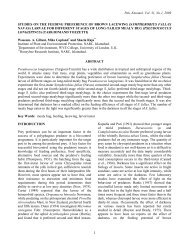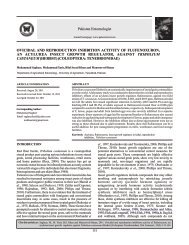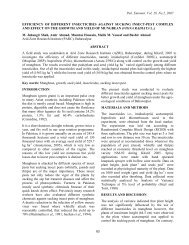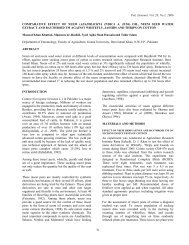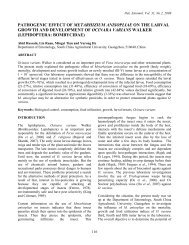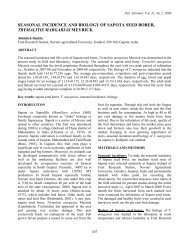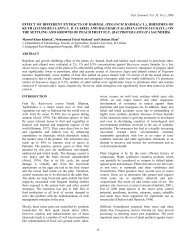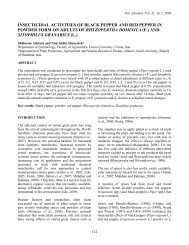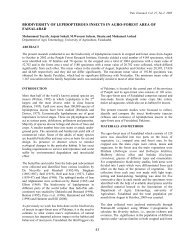Entomol. Journal Page Setting, all articles - Pakistan Entomologist
Entomol. Journal Page Setting, all articles - Pakistan Entomologist
Entomol. Journal Page Setting, all articles - Pakistan Entomologist
Create successful ePaper yourself
Turn your PDF publications into a flip-book with our unique Google optimized e-Paper software.
Manzoor et al. / <strong>Pakistan</strong> <strong>Entomol</strong>ogist 2011, 33(2): 125-130<br />
sustainable food production. Philos. Trans. R. Soc. Lond. Biol. Sci., Moreau, S.J.M. and S. Guillot, 2005. Advances and prospects on<br />
363: 761-776. biosynthesis, structures and functions of venom proteins from<br />
Beard, R.L., 1952. The toxicology of Habrobmcon venom: A study of a parasitic wasps. Insect Biochem. Mol. Biol., 35: 1209- 1223.<br />
natural insecticide. Conn. Agr. Exp. Sta. Bull., 562: 1-27.<br />
Nakamatsu, Y. and T. Tanaka, 2004. Venom of Euplectrus separate<br />
Benson, J.F., 1973. Intraspecific competition in the population dynamics causes hyperlipidemia by lysis of host fat body cells. J. Insect Physiol.,<br />
of Bracon hebetor (Say.) (Hymenoptera: Braconidae). J. Anim. 50: 267-275.<br />
Ecol., 42: 105-24.<br />
Parkinson, N., E.H. Richards, C. Conyers, I. Smith and J.P. Edwards,<br />
Burges, H.D., 1978. Control of wax moth: physical, chemical and 2002. Analysis of venom constituents from the parasitoid wasp<br />
biological methods. Bee World, 59 (4): 129-138.<br />
Pimpla hypochondriaca and cloning of a cDNA encoding a venom<br />
Caron, D.M., 1992. Wax moth. Americ. Bee J., 132 (10), 647-649. protein. Insect Biochem. Mol. Biol., 32: 729–735.<br />
Casida, J.E. and G.B. Quistad, 1998. Golden age of insecticide Pennacchio, F., C. Malva and S.B. Vinson, 2001. Regulation of host<br />
research: past, present, or future. Annu. Rev. <strong>Entomol</strong>., 43: 1-16.<br />
endocrine system by the endophagous braconid Cardiochiles<br />
Cline, L.D., J.W. Press and B.R. Flaherty, 1984. Preventing the spread of nigriceps and its polydnavirus. In: Manipulating Hormonal Control<br />
the Almond Moth (Lepidoptera: Pyralidae) from infested food debris (Endocrine Interactions). J. Edwards (ed.). BIOS Scientific Publisher,<br />
to adjacent uninfested packages, using the parasite Bracon hebetor Oxford, pp. 123-132.<br />
(Hymenoptera: Braconidae). J. Econ. <strong>Entomol</strong>., 77: 331-333.<br />
Pennacchio, F. and M. R.Strand, 2006. Evolution of developmental<br />
Copping, L.G. and J.J. Menn, 2000. Biopesticides: A review of their strategies in parasitic hymenoptera. Ann. Rev. <strong>Entomol</strong>., 51: 233-258.<br />
action, applications and efficacy. Pest Manag. Sci., 56 (8): 651- 676. Piek, T., 1966. Site of action of venom of Microbracon hebetor (Say)<br />
Coskun, M., T. Kayis, M. Sulanc and P. Ozalp, 2006. Effects of different (Hymenoptera: Braconidae). J. Insect Physiol., 12: 561-568.<br />
honey comb and sucrose levels on the development of greater wax Piek, T., W. Spanjer, K.D. Njio, R.L. Veenendaal and P. Mantel, 1974.<br />
moth G<strong>all</strong>eria mellonella larvae. Intern. J. Agri. Biol., 08(6): Paralysis caused by the venom of the wasp Microbracon gelechiae. J.<br />
855–858. Insect Physiol., 20: 2307-2319.<br />
Darwish, E., M. El-Shazly and H. El-Sherif, 2003. The choice of probing Pringl, J.W.S., 1938. proprioreception in insects. Experim. Biol., 5:101-<br />
sites by Bracon hebetor (Say) (Hymenoptera: Braconidae) foraging 103.<br />
for Ephestia kuehniella Zeller (Lepidoptera:Pyralidae). J. Stored Quistad, G.B., Leisy, D.J., 1996. Insecticidal toxins from the parasitic<br />
Prod. Res., 39: 265-276.<br />
wasp, Bracon hebetor. US Patent No.5,554,592.<br />
Dayan, F.E., C.L. Cantrell, S.O. Duke, 2009. Natural products in crop Rathmayer, W. and C. Walther, 1976. Mode of action and specificity of<br />
protection. Bioorg. Med. Chem., 17, 4022-4034. Habrobracon venom. In: Animal, Plant, and Microbial Toxins, 2: 299-<br />
Digilio, M.C., F. Pennacchio and E. Tremblay, 1998. Host regulation 307.<br />
effects of ovary fluid and venom of Aphidius ervi (Hymenoptera: Schmidt, O., U. Theopold and M.R. Strand, 2001. Innate immunity and<br />
Braconidae). J. Insect Physiol., 44 (9): 779-784.<br />
its evasion and suppression by hymenopteran endoparasitoids. Bio<br />
Digilio, M.C., N. Isidoro, E. Tremblay and F. Pennacchio, 2000. Host Essays, 23: 344-351.<br />
castration by Aphidius ervi venom proteins. J. Insect Physiol., 46: Smith, T.L., 1965. External morphology of the larva, pupa and adult of<br />
1041-1050. the wax moth G<strong>all</strong>eria mellonella. J. Kansas <strong>Entomol</strong>. Soci., 38 (3):<br />
Doury, G., Y. Bigot and G. Periquet, 1997. Physiological and 287-310.<br />
biochemical analysis of factors in the female venom gland and larval Tuncyurek, C.M., 1972. Bracon hebetor (Say) (Hymenoptera:<br />
salivary secretions of the ectoparasitoid wasp Eupelmus orientalis. J. Braconidae) ile Cadra cautella (Walk) ve Anagasta kuehniella<br />
Insect Physiol., 43: 69-81.<br />
(Zeller) (Lepidoptera: Pyralidae) 'Õye Karsõ Biyolojik Savas<br />
Dweck, H.K.M., P.S. Glenn, E.A. Gündüz and O. Anderbrant, 2010. Ümkanlarõ uzerinde Arastõrmalar, Teknik B.lten No: 20, Bornova<br />
Kairomonal response of the parasitoid, Bracon hebetor (Say.) to the Zirai Mucadele Arastõrma Ens, Üzmir.<br />
male-produced sex pheromone of its host, the greater wax moth, Uematsu, H. and A. Sakanoshita, 1987. Effects of venom from an<br />
G<strong>all</strong>eria mellonella (L.). J. Chem. Ecol., 36:171-178.<br />
external parasitoid, Euplectrus kuwanae (Hymenoptera: Eulophidae)<br />
Gul, M. and A. Gulel, 1995. Parasitoid Bracon hebetor (Say) on larval ecdysis of Argyrogramma albostriata (Lepidoptera:<br />
(Hymenoptera: Braconidae) Õun biyolojisi ve konak larva Noctuidae). Appl. <strong>Entomol</strong>., 22: 139-144.<br />
buyukluÛunun verim ve eßey oranõ uzerine etkisi. Tr. J. Zool., 19: Vinson, S.B. and G.F. Iwantsch, 1981. Host regulation by insect<br />
231-235. parasitoids. Quart. Rev. Biol., 55: 143-165.<br />
Haewoon, O., M. Young, and Y. Chang, 1995. Developing periods of Vinson, S.B., 1975. Biochemical coevolution between parasitoids and<br />
damage patterns of combs by the wax moth, G<strong>all</strong>eria mellonella. J. their hosts. In: Euolutionary Strategies of Parasitic Insects and Mites,<br />
Apicul. Res., 10 (1): 5-10. P. Price (ed.). 14-48.<br />
Hagstrum, D.W. and B.J. Smittle, 1977. Host-finding ability of Bracon Walther, C. and M. Reinecke, 1983. Block of synaptic vesicle exocytosis<br />
hebetor and its influence upon adult parasite survival and fecundity. without block of Ca+2-influx. An ultrastructural analysis of the<br />
Environ. <strong>Entomol</strong>., 6 : 437-439.<br />
paralysing action of Habrobracon venom on locust motor nerve<br />
Heimpel, G.E., M.F. Antolin, R.A. Franqui M.R. Strand, 1997. terminals. Neurosci., 9: 213-224.<br />
Reproductive isolation and genetic variation between two ''strains'' of Whetstone, P.A. and B.D. Hammock, 2007. Delivery methods for<br />
Bracon hebetor (Hymenoptera: Braconidae). Biol. Control., 9: 149- peptide and protein toxins in insect control. Toxicon., 49: 576-596.<br />
156. Windass, J.D., R.E. Duncan, P.D. Christian, V.J. Baule, 1996.<br />
Johnson, J.H., R.M. Kral Jr and K. Krapcho, 1996. International Patent- International Patent-WO 96/16171.<br />
WO 96/25429.<br />
Zhang, G., O. Schmidt, S. Asgari, 2004. A novel venom peptide from an<br />
Johnson, J.H., R.M. Kral Jr and K. Krapcho, 1999. United States Patent- endoparasitoid wasp is required for expression of polydnavirus genes<br />
No. 5, 874, 298. in host hemocytes. J. Biol. Chem., 279: 41580-41585.<br />
Khan, R.R., M. Ashfaq and S.A. Rana, 2005. Some studies on the<br />
toxicity of conventional and new chemistry insecticides against<br />
Bracon Hebetor (Say) (Hymenoptera: Braconidae) under laboratory<br />
conditions. Pak. <strong>Entomol</strong>., 27 (1): 19-21.<br />
Lavine, M.D. and M.R. Strand, 2002. Insect haemocytes and their role in<br />
immunity. Insect Biochem. Mol. Biol., 32: 1295-1309.<br />
Lawrence, P.O. and B. Lanzrein, 1993. Hormonal interactions between<br />
insect endoparasites and their host insects. In: Parasites and Pathogens<br />
of Insects, Beckage N.E., S.N. Thompson, and B.A Federici. (eds.),<br />
Academic Press, New York, pp. 59-86.<br />
Cite this article as:<br />
Manzoor, A., Zain-ul-Abdin, M. Arshad, M.D. Gogi, H. Shaina, E. Mubarik, S.K. Abbas and M.A. Khan, 2011. Biological activity<br />
of the toxic peptides from venom of Bracon hebetor (Say.) (Hymenoptera: Braconidae). Pak. <strong>Entomol</strong>., 33(2): 125-130.<br />
130



